NCERT Solutions for Class-12 Biology Chapter-5 Principles of Inheritance and Variation
NCERT EXERCISE
Solution:
(i) The plant shows clear-cut contrasting characters.
(ii) Hybrids are perfectly fertile.
(iii) Genes for the seven contrasting characters are located on seven separate chromosomes.
(iv) Easy to cultivate.
(v) The floral structure is suitable for artificial pollination.
(vi) Short growth period and life cycle.
(vii) Cross-pollination is easy if self-pollination is prevented.
(viii) Pure breeding varieties are available.
(i) Dominant and Recessive
(ii) Homozygous and Heterozygous
(iii) Monohybrid and Dihybrid
Solution:
(i) Differences between dominant and recessive genes are as follows:
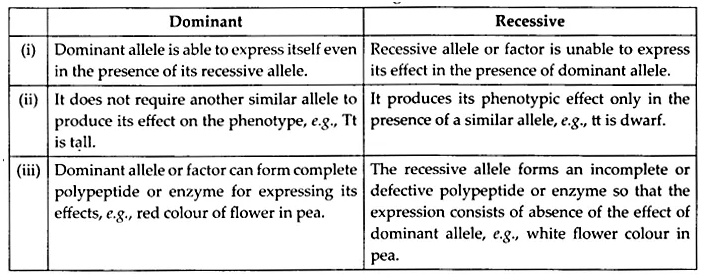 (ii) Differences between homozygous and heterozygous are as follows:
(ii) Differences between homozygous and heterozygous are as follows: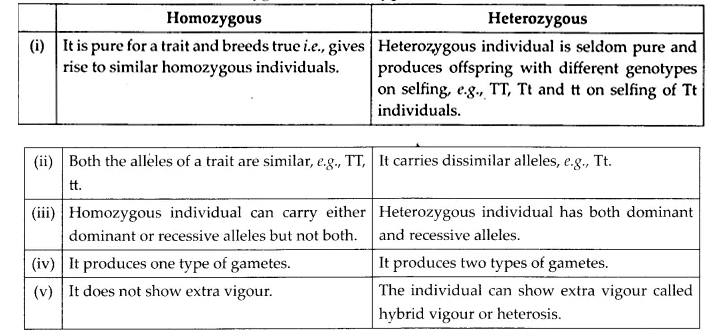 (iii) Differences between monohybrid and dihybrid cross are as follows:
(iii) Differences between monohybrid and dihybrid cross are as follows:
Question 3. A diploid organism is heterozygous for 4 loci, how many types of gametes can be produced?
Solution: A diploid organism heterozygous for 4 loci will have the supported genetic constitution YyRr for two characters. The alleles Y-y and R-r will be present on different 4 loci. Each parent will produce four types of gametes – YR, Yr, yR, yr.
Question 4. Explain the law of dominance using a monohybrid cross.
Solution: The Law of dominance states that when a pair of alleles or allelomorphs are brought together in F1 hybrid, then only one of them expresses itself, masking the expression of the other completely. Monohybrid cross was made to study the simultaneous inheritance of a single pair of Mendelian factors. The cross in which only alternate forms of a single character are taken into consideration is called a monohybrid cross. The trait which appeared in the F1 generation was called dominant and the other which did not appear in the F1 population was called recessive.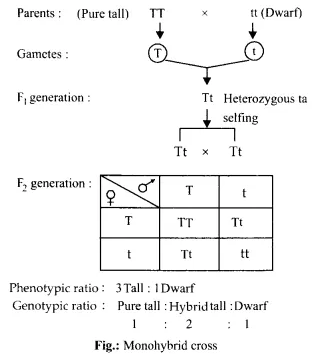
Thus, when a pair of alleles are brought together in an F1 hybrid, then only one of them expresses itself masking the expression of the other completely. In the above example, in Tt – F1 hybrid (tall) only ‘T’ expresses itself so dominant, and ‘t’ is masked so recessively. Thus, this’ proves and explains the law of dominance.
Question 5. Define and design a test-cross.
Solution: The crossing of F1 individuals having dominant phenotype with its homozygous recessive parent is called test cross. The test cross is used to determine whether the individuals exhibiting dominant character are homozygous or heterozygous.
Example: When a tall plant (TT) is crossed with the dwarf plant (tt) in the F1, generation only tall plant (Tt) appears which is then crossed with homozygous recessive (tt) in a test cross.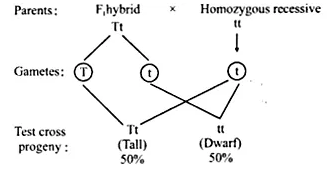
In the given test cross between tall heterozygous F1 hybrid with dwarf homozygous recessive parent produces tall and dwarf progeny in equal proportion indicating that F : hybrids are heterozygous.
Question 6. Using a Punnett square, work out the distribution of phenotypic features in the first filial generation after a cross between a homozygous female and a heterozygous male for a single locus.
Solution: When a heterozygous male tall plant (Tt) is crossed with the homozygous dominant female tall plant (TT), we get two types of gametes in males: half with T and a half with t, and in females, we get only one type of gametes i.e., T.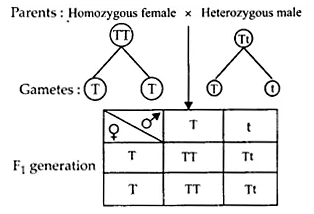
From the Punnett square it is seen that all the progeny in the F generation are tall (Tt), 50% homozygous tall (TT), and 50% heterozygous tall (Tt).
(i) tall and green
(ii) dwarf and green
Solution:
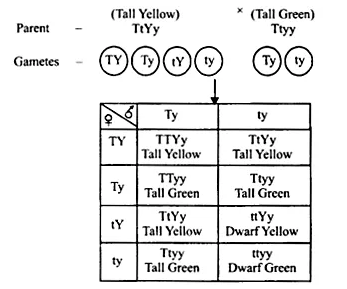
Phenotypes of the offsprings –
Tall Yellow: 3
Tall Green: 3
Dwarf Green: 1
Dwarf Yellow: 1
(a) Proportion of tall and green is 3/8.
(b) Proportion of dwarf and green is 1/8.
Question 8. Two heterozygous parents are crossed. If the two loci are linked what would be the distribution of phenotypic features in F1 generation for a dihybrid cross?
Solution: Two heterozygous parents (i.e. GgLl and GgLl) are crossed and the two loci are linked then the cross will be,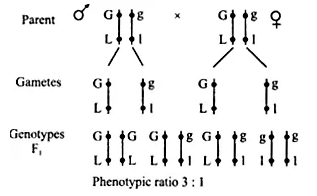
This means, if ‘G’ represent grey body (dorhinant), ‘g’ black body (recessive), ‘L’-long (dominant) and ‘I’-dwarf (recessive) then the distribution of phenotypic features in F1 generation will be 3 : 1 i.e. 3/4 will show the dominant feature, grey and long, either in homozygous (GGLL) or in heterozygous (GgLl) condition and 1/4 will show the recessive feature, black and dwarf (ggll).
Solution: TH Morgan is a Geneticist who got Nobel Prize.
(i) He found fruit fly (Drosophila Melanogaster) to be an experimental material as it was easy to rear and multiply.
(ii) The established presence of genes over the chromosomes.
(iii) Principle of linkage and crossing over.
(iv) Discovered sex linkage and crossing over.
(v) He observed mutations.
(vi) The developed technique of chromosome mapping,
(vii) Wrote the book “The theory of Gene”.
Solution: A record of inheritance of certain genetic traits for two or more generations presented in the form of a diagram of family tree is called pedigree. Pedigree analysis is study of pedigree for the transmission of particular trait and finding the possibility of absence or presence of that trait in homozygous or heterozygous state in a particular individual. Pedigree analysis is useful for the following:
(i) It is useful for the genetic counsellors to advice intending couples about the possibility of having children with genetic defects like haemophilia, colour blindness, alkaptonuria, phenylketonuria, thalassemia, sickle cell anaemia (recessive traits), brachydactyly and syndactyly (dominant traits).
(ii) Pedigree analysis indicates that Mendel’s principles are also applicable to human genetics with some modifications found out later like quantitative inheritance, sex linked characters and other linkages.
(iii) It can indicate the origin of a trait in the ancestors, e.g., haemophilia appeared in Queen Victoria and spread in royal families of Europe through marriages.
(iv) It helps to know the possibility of a recessive allele to create a disorder in the progeny like thalassemia, muscular dystrophy, haemophilia.
(v) It can indicate about the harm that a marriage between close relatives, may cause.
(vi) It helps to identify whether a particular genetic disease is due to a recessive gene or a dominant gene.
(vii) In certain cases it may help to identify the genotypes of offspring yet to be born.
Question 11. How is sex determined in human beings?
Solution: In humans, there are 23 pairs of chromosomes. 22 pairs of these chromosomes do not take part in sex determination called autosomes. The 23rd pair determines the sex of an individual called allosome or sex chromosome. If it is XX then female, if XY then male. The presence of Y1 makes a person male. Human females produce only 1 type of gamete 22 + X. In males, it could be 22 + X or 22+ Y.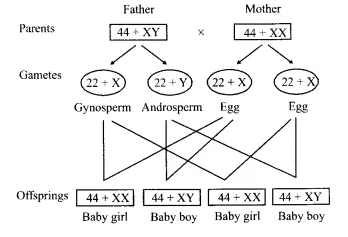
Question 12. A child has blood group O. If the father has blood group A and mother blood group B, work out the genotypes of the parents and the possible genotypes of the other offsprings.
Solution: If the father has blood group A i.e., IAIA (homozygous) and mother has blood group B i.e., IBIB (homozygous) then all the offsprings will have blood group AB (IAIB) and not blood group O.
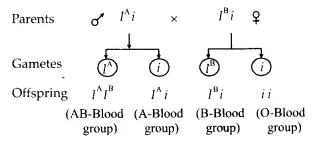
Thus the genotypes of the parents of child with blood group O will be IAi and IBi There is the possibility of 3 other types of blood groups of offsprings besides O blood group offspring. They are IAi (blood group A). IBi (blood group B) and IAIB (blood group AB).
(i) Codominance
(ii) Incomplete dominance
Solution: Codominance (1 : 2 : 1) — It is the phenomenon of two alleles (different forms of a Mendelian factor present on the same gene locus on homologous chromosomes) lacking dominant- recessive relationship and are able to express themselves independently when present together.
Example – AB blood group: Alleles for blood group A(IA) and blood group B(IB) are codominant so that when they come together in an individual, they produce blood group AB. It is characterized by the presence of both antigen A (from IA) and antigen B (from IB) over the surface of erythrocytes.

Incomplete dominance (1 : 2 : 1) – It is the phenomenon where none of the two contrasting alleles being dominant so that expression in the hybrid is intermediate between the expressions of the two alleles in the homozygous state. F2 phenotypic ratio is 1 : 2 : 1, similar to genotypic ratio. Example-In Mirabilis jalapa (Four o’clock) and Antirrhinum majus (Snapdragon or dog flower), there are two types of flower colour generation are of three types- red, pink and white flowered in the ratio of 1 : 2 : 1. The pink colour apparently appears either due to the mixing of red and white colours (incomplete dominance).
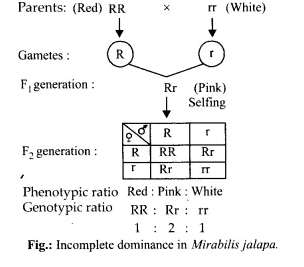
Question 14. What is point mutation? Give one example.
Solution: Point mutation is a gene mutation that arises due to a change in a single base pair of DNA.
Example: Sickle-cell anaemia.
Substitution of a single nitrogen base at the sixth codon of the β- globin chain of haemoglobin molecule causes the change in the shape of the R.B.C. from biconcave disc to the elongated shaped, structure which results in sickle cell anaemia.
Question 15. Who had proposed the chromosomal theory of inheritance?
Solution: Sutton and Boveri proposed the chromosomal theory of inheritance. The theory believes that chromosomes are vehicles of hereditary information that possess mendelian factors or genes and it is the chromosomes which segregate and assort independently during transmission from one generation to the next.
Solution: Cystic fibrosis is an autosomal recessive disorder of infants, children, and young adults that is due to a recessive autosomal allele present on chromosome 7. It is common in Caucasian Northern Europeans and White North Americans. The disease gets its name from the fibrous cysts that appear in the pancreas. In 70% of cases, it is due to the deletion of three bases. It produces a defective glycoprotein. The defective glycoprotein causes the formation of thick mucus in the skin, lungs, pancreas, liver, and other secretory organs. Accumulation of thick mucus in the lungs results in obstruction of airways. Because of it, the disease was also called mucoviscoides, Mucus deposition in the pancreas blocks secretion of pancreatic juice. There is a maldigestion of food with high-fat content in the stool. The liver may undergo cirrhosis and there is impaired production of bile. Vasa deferentia of males undergo atrophy.
Huntington’s disease or Huntington’s chorea is a dominantly autosomal inherited disorder in which muscle and mental deterioration occur. There is gradual loss of motor control resulting in uncontrollable shaking and dance-like movements (chorea). The brain shrinks between 20-30% in size followed by slurring of speech, loss of memory, and hallucinations. Life expectancy averages 15 years from the onset of symptoms. This disorder does not occur till the age of 25 to 55. The defective gene is dominant autosomal, located on chromosome 4. This defective gene has 42 -100 repeats of CAG instead of 10-34 repeats in the normal gene. The frequency of this disorder is 1 in 10000 to 1 in 20000.

0 comment
Post a Comment